Comprehensive Report on Sustainable Tourism Development in Qatar
VerifiedAdded on 2021/01/02
|12
|3475
|244
Report
AI Summary
This report provides a detailed analysis of sustainable tourism development in Qatar, addressing various facets of the industry. It begins with an introduction to the challenges and goals of sustainable tourism, emphasizing its focus on economic opportunity, quality of life, and environmental and cultural heritage protection. The report then delves into the benefits for different stakeholders, including operators, investors, and the local community, followed by an examination of public-private partnerships, outlining their advantages and disadvantages in the context of Qatar. The report further explores tourism development planning at international, national, regional, and sub-regional levels, highlighting the importance of interactive planning systems and processes. It also discusses methods for measuring the impacts of tourism, such as the Cambridge Economic Impact Model and environmental impact studies. The concept of sustainability in tourism is justified through the triple bottom line theory, examining social, environmental, and economic dimensions. Factors hindering sustainable tourism development, such as social justice, climate change, and tourism policies, are also discussed. The report outlines the stages of sustainable tourism planning, from study recognition to monitoring, and addresses methods for resolving conflicts of interest to ensure future well-being. The report concludes with a comparison of tourism development issues in Qatar and South Africa, offering recommendations for the future development of tourism in Qatar.
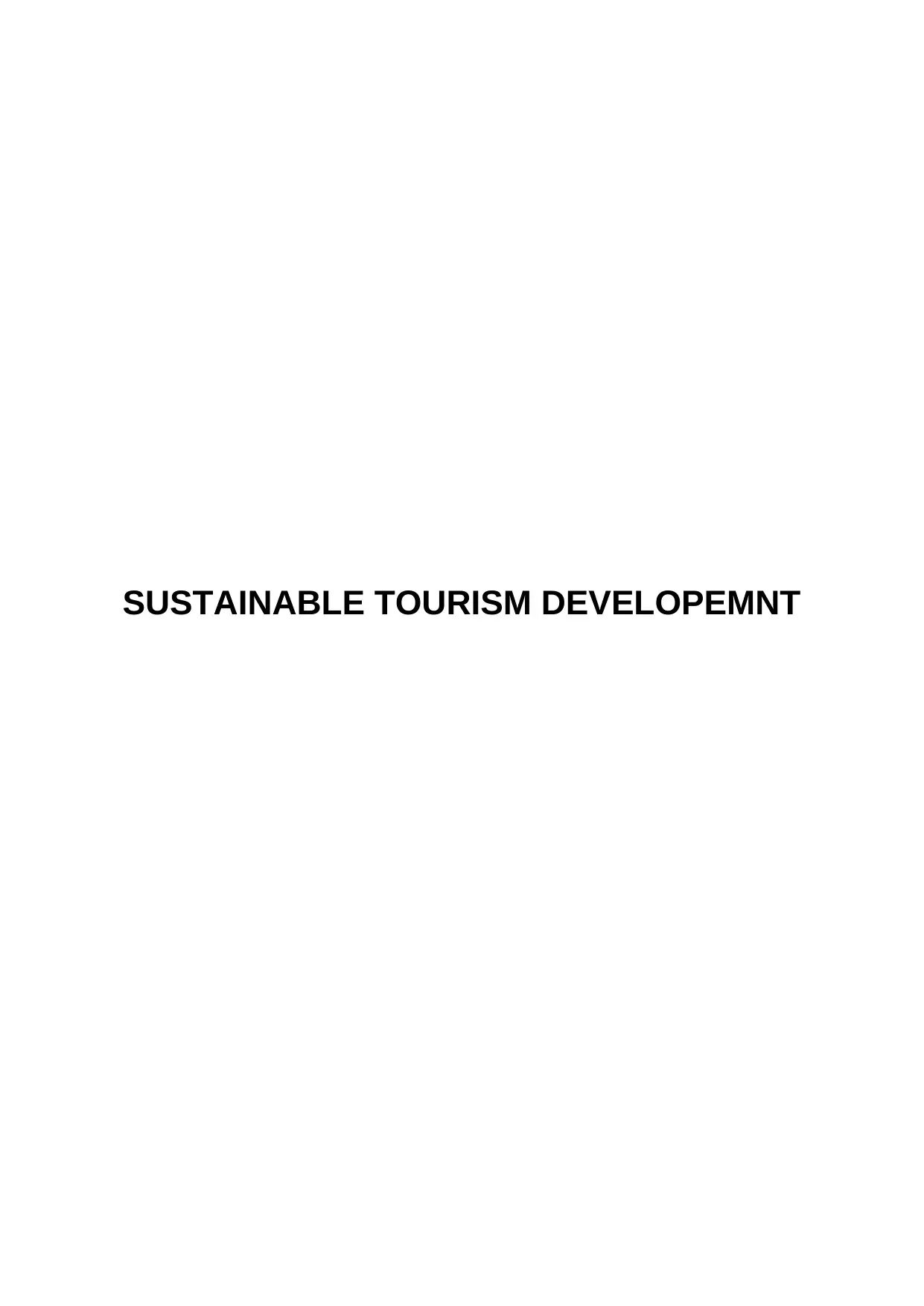
SUSTAINABLE TOURISM DEVELOPEMNT
Paraphrase This Document
Need a fresh take? Get an instant paraphrase of this document with our AI Paraphraser
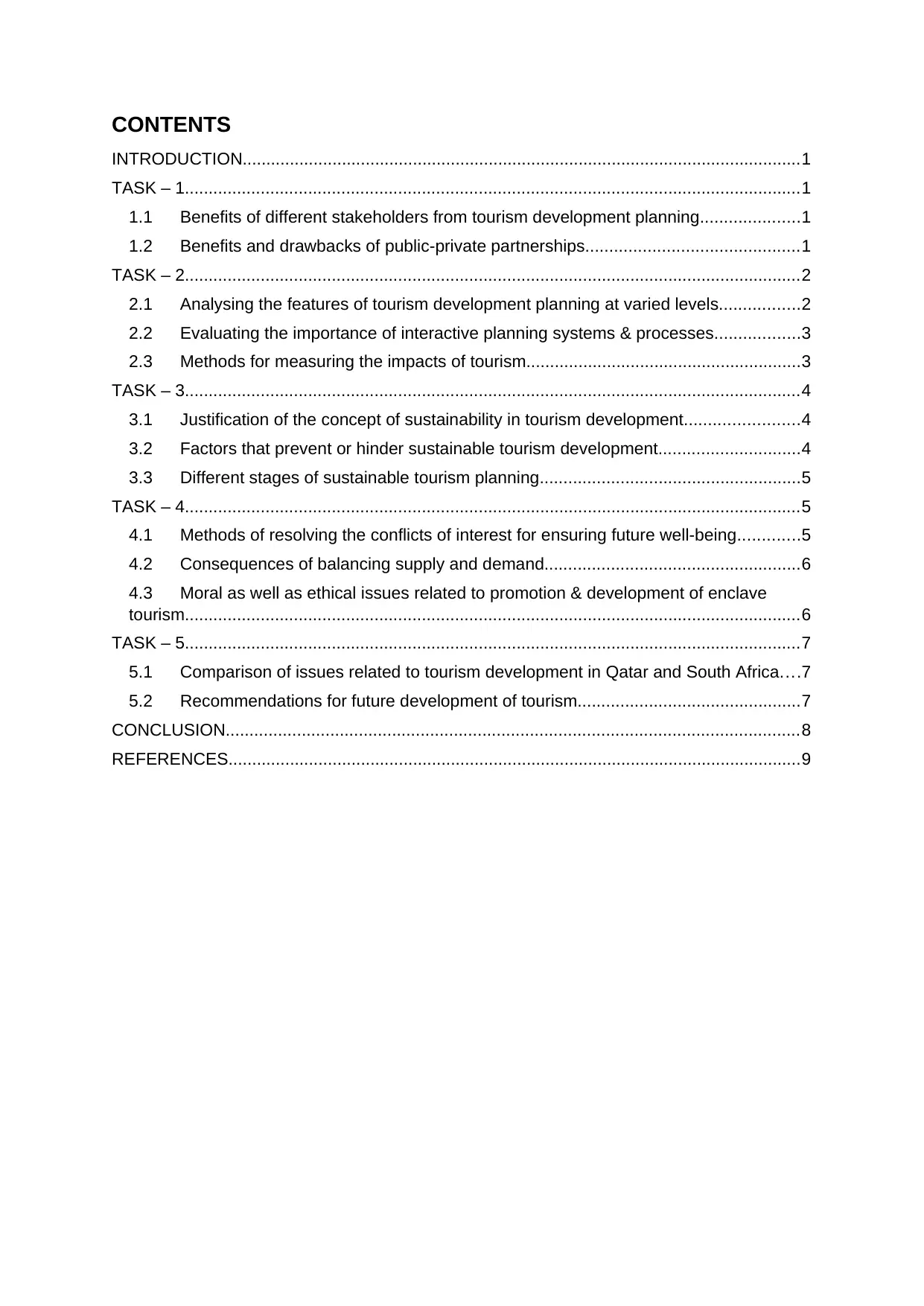
CONTENTS
INTRODUCTION......................................................................................................................1
TASK – 1..................................................................................................................................1
1.1 Benefits of different stakeholders from tourism development planning.....................1
1.2 Benefits and drawbacks of public-private partnerships.............................................1
TASK – 2..................................................................................................................................2
2.1 Analysing the features of tourism development planning at varied levels.................2
2.2 Evaluating the importance of interactive planning systems & processes..................3
2.3 Methods for measuring the impacts of tourism..........................................................3
TASK – 3..................................................................................................................................4
3.1 Justification of the concept of sustainability in tourism development........................4
3.2 Factors that prevent or hinder sustainable tourism development..............................4
3.3 Different stages of sustainable tourism planning.......................................................5
TASK – 4..................................................................................................................................5
4.1 Methods of resolving the conflicts of interest for ensuring future well-being.............5
4.2 Consequences of balancing supply and demand......................................................6
4.3 Moral as well as ethical issues related to promotion & development of enclave
tourism..................................................................................................................................6
TASK – 5..................................................................................................................................7
5.1 Comparison of issues related to tourism development in Qatar and South Africa....7
5.2 Recommendations for future development of tourism...............................................7
CONCLUSION.........................................................................................................................8
REFERENCES.........................................................................................................................9
INTRODUCTION......................................................................................................................1
TASK – 1..................................................................................................................................1
1.1 Benefits of different stakeholders from tourism development planning.....................1
1.2 Benefits and drawbacks of public-private partnerships.............................................1
TASK – 2..................................................................................................................................2
2.1 Analysing the features of tourism development planning at varied levels.................2
2.2 Evaluating the importance of interactive planning systems & processes..................3
2.3 Methods for measuring the impacts of tourism..........................................................3
TASK – 3..................................................................................................................................4
3.1 Justification of the concept of sustainability in tourism development........................4
3.2 Factors that prevent or hinder sustainable tourism development..............................4
3.3 Different stages of sustainable tourism planning.......................................................5
TASK – 4..................................................................................................................................5
4.1 Methods of resolving the conflicts of interest for ensuring future well-being.............5
4.2 Consequences of balancing supply and demand......................................................6
4.3 Moral as well as ethical issues related to promotion & development of enclave
tourism..................................................................................................................................6
TASK – 5..................................................................................................................................7
5.1 Comparison of issues related to tourism development in Qatar and South Africa....7
5.2 Recommendations for future development of tourism...............................................7
CONCLUSION.........................................................................................................................8
REFERENCES.........................................................................................................................9
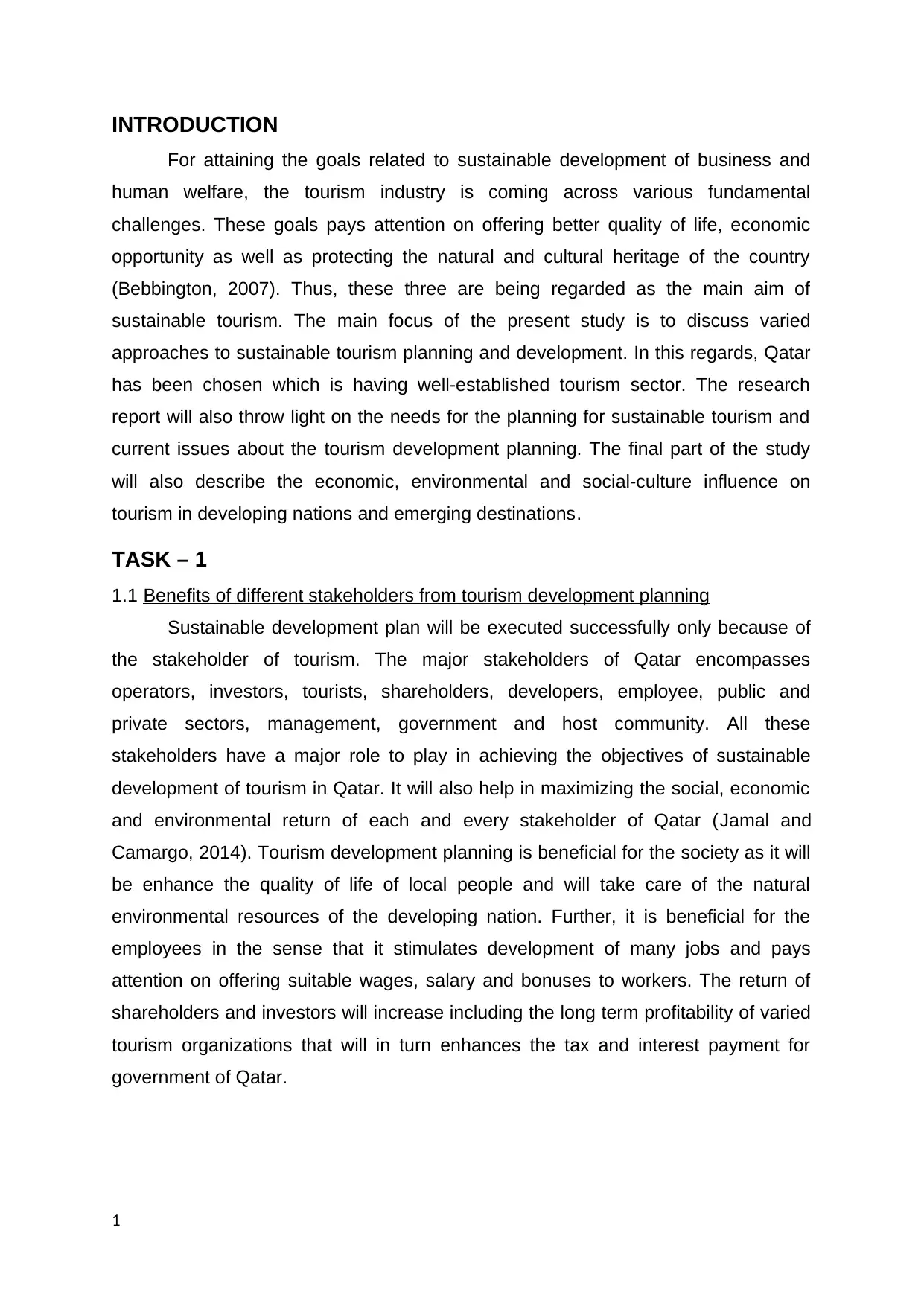
INTRODUCTION
For attaining the goals related to sustainable development of business and
human welfare, the tourism industry is coming across various fundamental
challenges. These goals pays attention on offering better quality of life, economic
opportunity as well as protecting the natural and cultural heritage of the country
(Bebbington, 2007). Thus, these three are being regarded as the main aim of
sustainable tourism. The main focus of the present study is to discuss varied
approaches to sustainable tourism planning and development. In this regards, Qatar
has been chosen which is having well-established tourism sector. The research
report will also throw light on the needs for the planning for sustainable tourism and
current issues about the tourism development planning. The final part of the study
will also describe the economic, environmental and social-culture influence on
tourism in developing nations and emerging destinations.
TASK – 1
1.1 Benefits of different stakeholders from tourism development planning
Sustainable development plan will be executed successfully only because of
the stakeholder of tourism. The major stakeholders of Qatar encompasses
operators, investors, tourists, shareholders, developers, employee, public and
private sectors, management, government and host community. All these
stakeholders have a major role to play in achieving the objectives of sustainable
development of tourism in Qatar. It will also help in maximizing the social, economic
and environmental return of each and every stakeholder of Qatar (Jamal and
Camargo, 2014). Tourism development planning is beneficial for the society as it will
be enhance the quality of life of local people and will take care of the natural
environmental resources of the developing nation. Further, it is beneficial for the
employees in the sense that it stimulates development of many jobs and pays
attention on offering suitable wages, salary and bonuses to workers. The return of
shareholders and investors will increase including the long term profitability of varied
tourism organizations that will in turn enhances the tax and interest payment for
government of Qatar.
1
For attaining the goals related to sustainable development of business and
human welfare, the tourism industry is coming across various fundamental
challenges. These goals pays attention on offering better quality of life, economic
opportunity as well as protecting the natural and cultural heritage of the country
(Bebbington, 2007). Thus, these three are being regarded as the main aim of
sustainable tourism. The main focus of the present study is to discuss varied
approaches to sustainable tourism planning and development. In this regards, Qatar
has been chosen which is having well-established tourism sector. The research
report will also throw light on the needs for the planning for sustainable tourism and
current issues about the tourism development planning. The final part of the study
will also describe the economic, environmental and social-culture influence on
tourism in developing nations and emerging destinations.
TASK – 1
1.1 Benefits of different stakeholders from tourism development planning
Sustainable development plan will be executed successfully only because of
the stakeholder of tourism. The major stakeholders of Qatar encompasses
operators, investors, tourists, shareholders, developers, employee, public and
private sectors, management, government and host community. All these
stakeholders have a major role to play in achieving the objectives of sustainable
development of tourism in Qatar. It will also help in maximizing the social, economic
and environmental return of each and every stakeholder of Qatar (Jamal and
Camargo, 2014). Tourism development planning is beneficial for the society as it will
be enhance the quality of life of local people and will take care of the natural
environmental resources of the developing nation. Further, it is beneficial for the
employees in the sense that it stimulates development of many jobs and pays
attention on offering suitable wages, salary and bonuses to workers. The return of
shareholders and investors will increase including the long term profitability of varied
tourism organizations that will in turn enhances the tax and interest payment for
government of Qatar.
1
⊘ This is a preview!⊘
Do you want full access?
Subscribe today to unlock all pages.

Trusted by 1+ million students worldwide
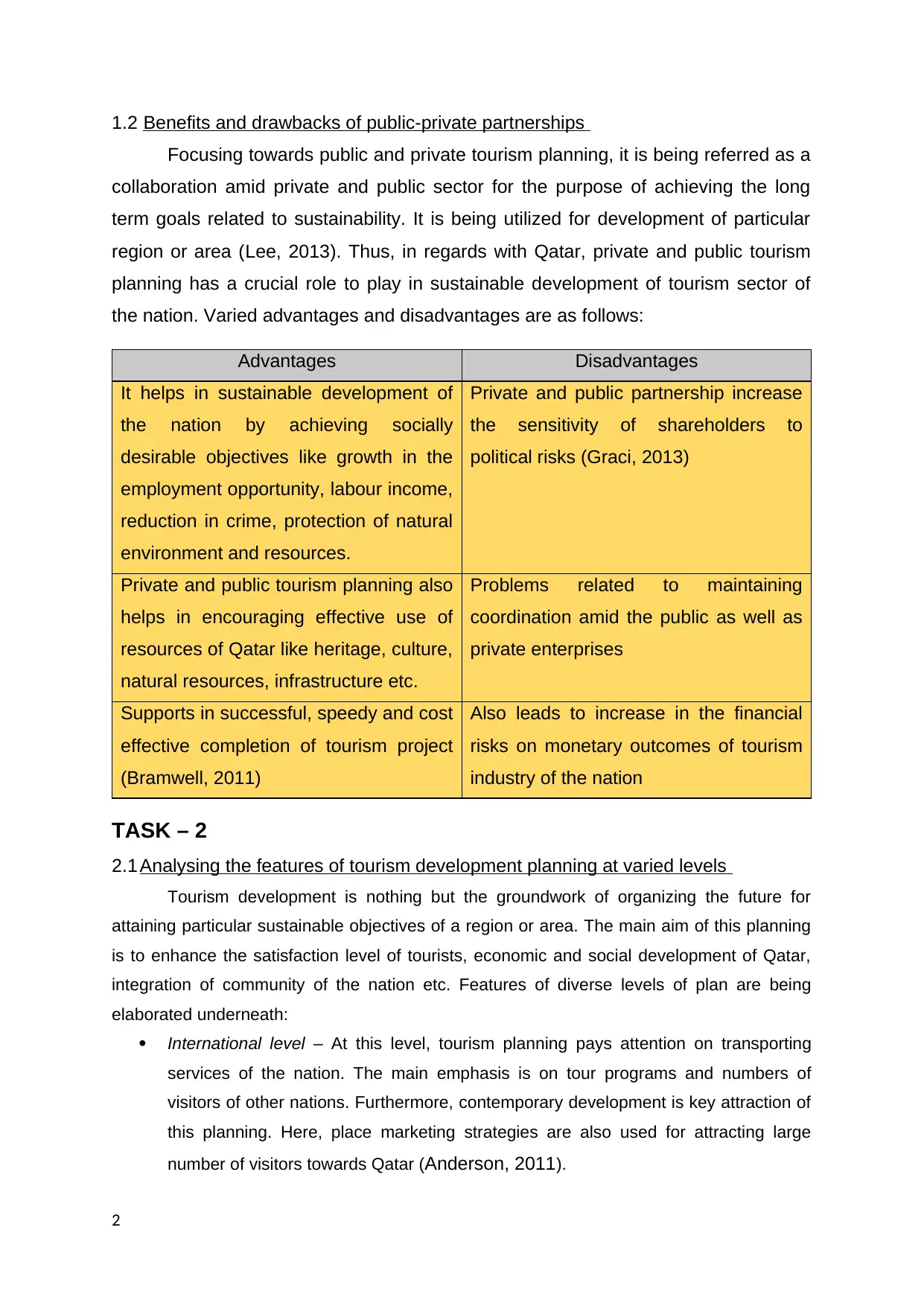
1.2 Benefits and drawbacks of public-private partnerships
Focusing towards public and private tourism planning, it is being referred as a
collaboration amid private and public sector for the purpose of achieving the long
term goals related to sustainability. It is being utilized for development of particular
region or area (Lee, 2013). Thus, in regards with Qatar, private and public tourism
planning has a crucial role to play in sustainable development of tourism sector of
the nation. Varied advantages and disadvantages are as follows:
Advantages Disadvantages
It helps in sustainable development of
the nation by achieving socially
desirable objectives like growth in the
employment opportunity, labour income,
reduction in crime, protection of natural
environment and resources.
Private and public partnership increase
the sensitivity of shareholders to
political risks (Graci, 2013)
Private and public tourism planning also
helps in encouraging effective use of
resources of Qatar like heritage, culture,
natural resources, infrastructure etc.
Problems related to maintaining
coordination amid the public as well as
private enterprises
Supports in successful, speedy and cost
effective completion of tourism project
(Bramwell, 2011)
Also leads to increase in the financial
risks on monetary outcomes of tourism
industry of the nation
TASK – 2
2.1 Analysing the features of tourism development planning at varied levels
Tourism development is nothing but the groundwork of organizing the future for
attaining particular sustainable objectives of a region or area. The main aim of this planning
is to enhance the satisfaction level of tourists, economic and social development of Qatar,
integration of community of the nation etc. Features of diverse levels of plan are being
elaborated underneath:
International level – At this level, tourism planning pays attention on transporting
services of the nation. The main emphasis is on tour programs and numbers of
visitors of other nations. Furthermore, contemporary development is key attraction of
this planning. Here, place marketing strategies are also used for attracting large
number of visitors towards Qatar (Anderson, 2011).
2
Focusing towards public and private tourism planning, it is being referred as a
collaboration amid private and public sector for the purpose of achieving the long
term goals related to sustainability. It is being utilized for development of particular
region or area (Lee, 2013). Thus, in regards with Qatar, private and public tourism
planning has a crucial role to play in sustainable development of tourism sector of
the nation. Varied advantages and disadvantages are as follows:
Advantages Disadvantages
It helps in sustainable development of
the nation by achieving socially
desirable objectives like growth in the
employment opportunity, labour income,
reduction in crime, protection of natural
environment and resources.
Private and public partnership increase
the sensitivity of shareholders to
political risks (Graci, 2013)
Private and public tourism planning also
helps in encouraging effective use of
resources of Qatar like heritage, culture,
natural resources, infrastructure etc.
Problems related to maintaining
coordination amid the public as well as
private enterprises
Supports in successful, speedy and cost
effective completion of tourism project
(Bramwell, 2011)
Also leads to increase in the financial
risks on monetary outcomes of tourism
industry of the nation
TASK – 2
2.1 Analysing the features of tourism development planning at varied levels
Tourism development is nothing but the groundwork of organizing the future for
attaining particular sustainable objectives of a region or area. The main aim of this planning
is to enhance the satisfaction level of tourists, economic and social development of Qatar,
integration of community of the nation etc. Features of diverse levels of plan are being
elaborated underneath:
International level – At this level, tourism planning pays attention on transporting
services of the nation. The main emphasis is on tour programs and numbers of
visitors of other nations. Furthermore, contemporary development is key attraction of
this planning. Here, place marketing strategies are also used for attracting large
number of visitors towards Qatar (Anderson, 2011).
2
Paraphrase This Document
Need a fresh take? Get an instant paraphrase of this document with our AI Paraphraser
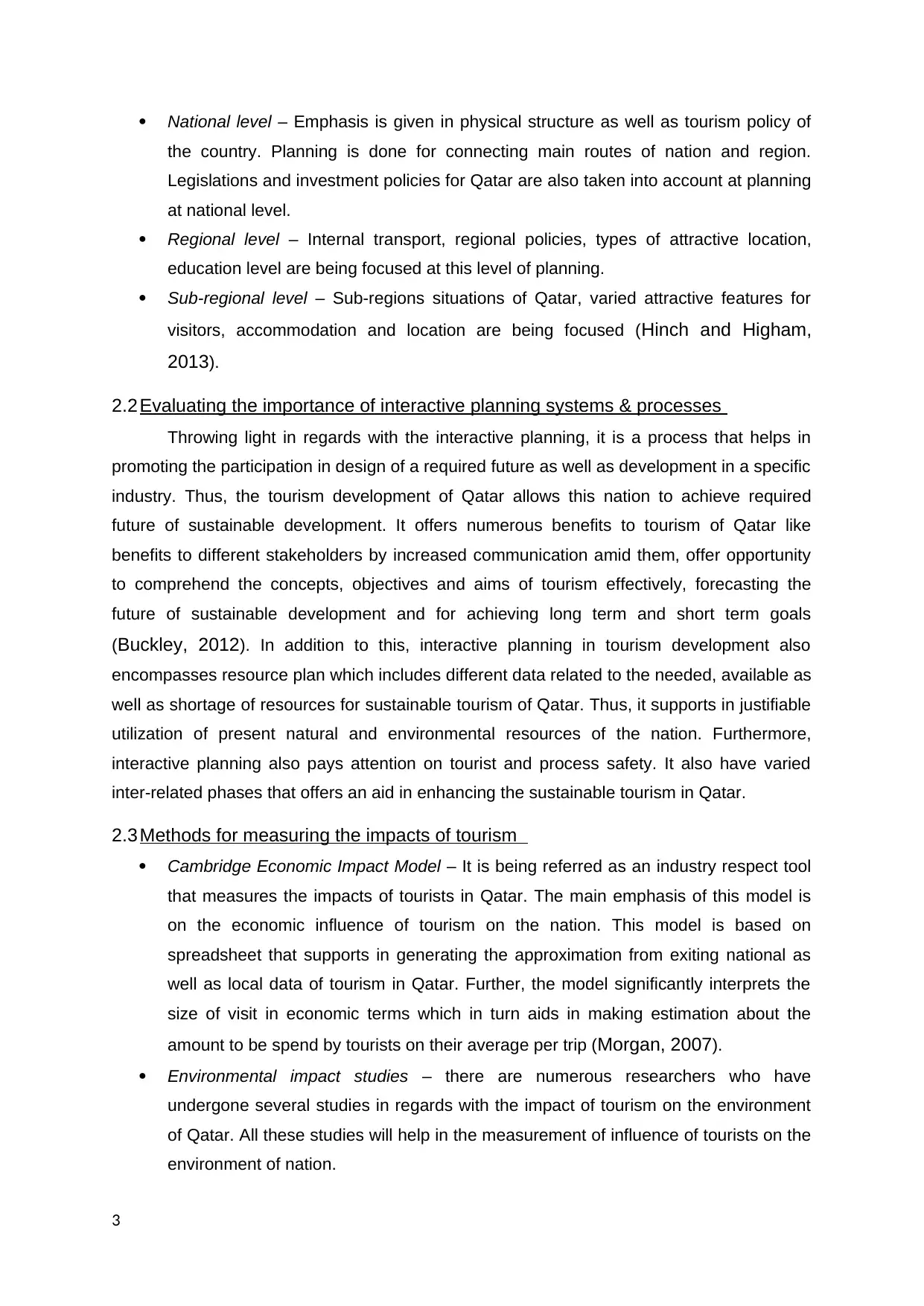
National level – Emphasis is given in physical structure as well as tourism policy of
the country. Planning is done for connecting main routes of nation and region.
Legislations and investment policies for Qatar are also taken into account at planning
at national level.
Regional level – Internal transport, regional policies, types of attractive location,
education level are being focused at this level of planning.
Sub-regional level – Sub-regions situations of Qatar, varied attractive features for
visitors, accommodation and location are being focused (Hinch and Higham,
2013).
2.2 Evaluating the importance of interactive planning systems & processes
Throwing light in regards with the interactive planning, it is a process that helps in
promoting the participation in design of a required future as well as development in a specific
industry. Thus, the tourism development of Qatar allows this nation to achieve required
future of sustainable development. It offers numerous benefits to tourism of Qatar like
benefits to different stakeholders by increased communication amid them, offer opportunity
to comprehend the concepts, objectives and aims of tourism effectively, forecasting the
future of sustainable development and for achieving long term and short term goals
(Buckley, 2012). In addition to this, interactive planning in tourism development also
encompasses resource plan which includes different data related to the needed, available as
well as shortage of resources for sustainable tourism of Qatar. Thus, it supports in justifiable
utilization of present natural and environmental resources of the nation. Furthermore,
interactive planning also pays attention on tourist and process safety. It also have varied
inter-related phases that offers an aid in enhancing the sustainable tourism in Qatar.
2.3 Methods for measuring the impacts of tourism
Cambridge Economic Impact Model – It is being referred as an industry respect tool
that measures the impacts of tourists in Qatar. The main emphasis of this model is
on the economic influence of tourism on the nation. This model is based on
spreadsheet that supports in generating the approximation from exiting national as
well as local data of tourism in Qatar. Further, the model significantly interprets the
size of visit in economic terms which in turn aids in making estimation about the
amount to be spend by tourists on their average per trip (Morgan, 2007).
Environmental impact studies – there are numerous researchers who have
undergone several studies in regards with the impact of tourism on the environment
of Qatar. All these studies will help in the measurement of influence of tourists on the
environment of nation.
3
the country. Planning is done for connecting main routes of nation and region.
Legislations and investment policies for Qatar are also taken into account at planning
at national level.
Regional level – Internal transport, regional policies, types of attractive location,
education level are being focused at this level of planning.
Sub-regional level – Sub-regions situations of Qatar, varied attractive features for
visitors, accommodation and location are being focused (Hinch and Higham,
2013).
2.2 Evaluating the importance of interactive planning systems & processes
Throwing light in regards with the interactive planning, it is a process that helps in
promoting the participation in design of a required future as well as development in a specific
industry. Thus, the tourism development of Qatar allows this nation to achieve required
future of sustainable development. It offers numerous benefits to tourism of Qatar like
benefits to different stakeholders by increased communication amid them, offer opportunity
to comprehend the concepts, objectives and aims of tourism effectively, forecasting the
future of sustainable development and for achieving long term and short term goals
(Buckley, 2012). In addition to this, interactive planning in tourism development also
encompasses resource plan which includes different data related to the needed, available as
well as shortage of resources for sustainable tourism of Qatar. Thus, it supports in justifiable
utilization of present natural and environmental resources of the nation. Furthermore,
interactive planning also pays attention on tourist and process safety. It also have varied
inter-related phases that offers an aid in enhancing the sustainable tourism in Qatar.
2.3 Methods for measuring the impacts of tourism
Cambridge Economic Impact Model – It is being referred as an industry respect tool
that measures the impacts of tourists in Qatar. The main emphasis of this model is
on the economic influence of tourism on the nation. This model is based on
spreadsheet that supports in generating the approximation from exiting national as
well as local data of tourism in Qatar. Further, the model significantly interprets the
size of visit in economic terms which in turn aids in making estimation about the
amount to be spend by tourists on their average per trip (Morgan, 2007).
Environmental impact studies – there are numerous researchers who have
undergone several studies in regards with the impact of tourism on the environment
of Qatar. All these studies will help in the measurement of influence of tourists on the
environment of nation.
3
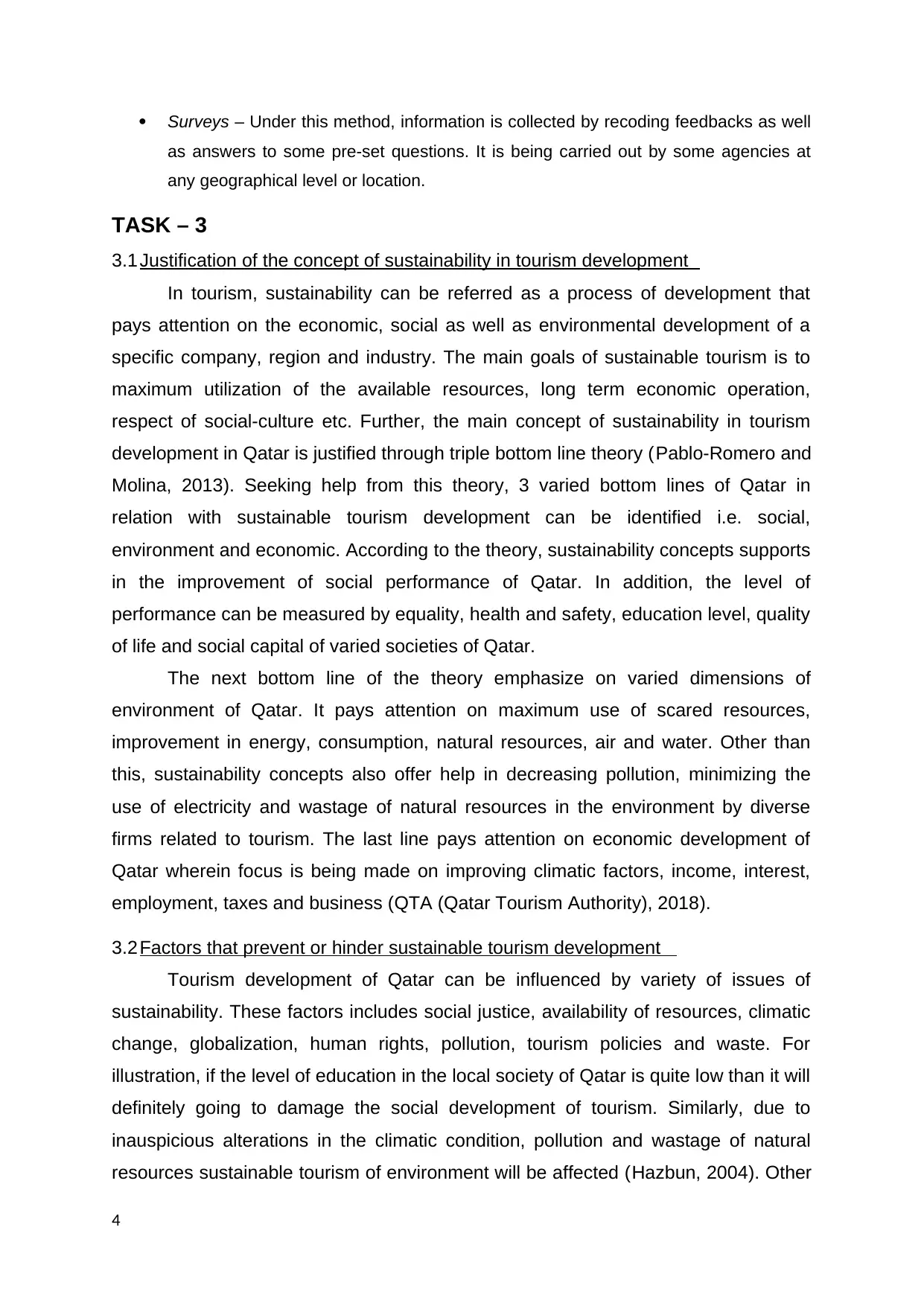
Surveys – Under this method, information is collected by recoding feedbacks as well
as answers to some pre-set questions. It is being carried out by some agencies at
any geographical level or location.
TASK – 3
3.1 Justification of the concept of sustainability in tourism development
In tourism, sustainability can be referred as a process of development that
pays attention on the economic, social as well as environmental development of a
specific company, region and industry. The main goals of sustainable tourism is to
maximum utilization of the available resources, long term economic operation,
respect of social-culture etc. Further, the main concept of sustainability in tourism
development in Qatar is justified through triple bottom line theory (Pablo-Romero and
Molina, 2013). Seeking help from this theory, 3 varied bottom lines of Qatar in
relation with sustainable tourism development can be identified i.e. social,
environment and economic. According to the theory, sustainability concepts supports
in the improvement of social performance of Qatar. In addition, the level of
performance can be measured by equality, health and safety, education level, quality
of life and social capital of varied societies of Qatar.
The next bottom line of the theory emphasize on varied dimensions of
environment of Qatar. It pays attention on maximum use of scared resources,
improvement in energy, consumption, natural resources, air and water. Other than
this, sustainability concepts also offer help in decreasing pollution, minimizing the
use of electricity and wastage of natural resources in the environment by diverse
firms related to tourism. The last line pays attention on economic development of
Qatar wherein focus is being made on improving climatic factors, income, interest,
employment, taxes and business (QTA (Qatar Tourism Authority), 2018).
3.2 Factors that prevent or hinder sustainable tourism development
Tourism development of Qatar can be influenced by variety of issues of
sustainability. These factors includes social justice, availability of resources, climatic
change, globalization, human rights, pollution, tourism policies and waste. For
illustration, if the level of education in the local society of Qatar is quite low than it will
definitely going to damage the social development of tourism. Similarly, due to
inauspicious alterations in the climatic condition, pollution and wastage of natural
resources sustainable tourism of environment will be affected (Hazbun, 2004). Other
4
as answers to some pre-set questions. It is being carried out by some agencies at
any geographical level or location.
TASK – 3
3.1 Justification of the concept of sustainability in tourism development
In tourism, sustainability can be referred as a process of development that
pays attention on the economic, social as well as environmental development of a
specific company, region and industry. The main goals of sustainable tourism is to
maximum utilization of the available resources, long term economic operation,
respect of social-culture etc. Further, the main concept of sustainability in tourism
development in Qatar is justified through triple bottom line theory (Pablo-Romero and
Molina, 2013). Seeking help from this theory, 3 varied bottom lines of Qatar in
relation with sustainable tourism development can be identified i.e. social,
environment and economic. According to the theory, sustainability concepts supports
in the improvement of social performance of Qatar. In addition, the level of
performance can be measured by equality, health and safety, education level, quality
of life and social capital of varied societies of Qatar.
The next bottom line of the theory emphasize on varied dimensions of
environment of Qatar. It pays attention on maximum use of scared resources,
improvement in energy, consumption, natural resources, air and water. Other than
this, sustainability concepts also offer help in decreasing pollution, minimizing the
use of electricity and wastage of natural resources in the environment by diverse
firms related to tourism. The last line pays attention on economic development of
Qatar wherein focus is being made on improving climatic factors, income, interest,
employment, taxes and business (QTA (Qatar Tourism Authority), 2018).
3.2 Factors that prevent or hinder sustainable tourism development
Tourism development of Qatar can be influenced by variety of issues of
sustainability. These factors includes social justice, availability of resources, climatic
change, globalization, human rights, pollution, tourism policies and waste. For
illustration, if the level of education in the local society of Qatar is quite low than it will
definitely going to damage the social development of tourism. Similarly, due to
inauspicious alterations in the climatic condition, pollution and wastage of natural
resources sustainable tourism of environment will be affected (Hazbun, 2004). Other
4
⊘ This is a preview!⊘
Do you want full access?
Subscribe today to unlock all pages.

Trusted by 1+ million students worldwide
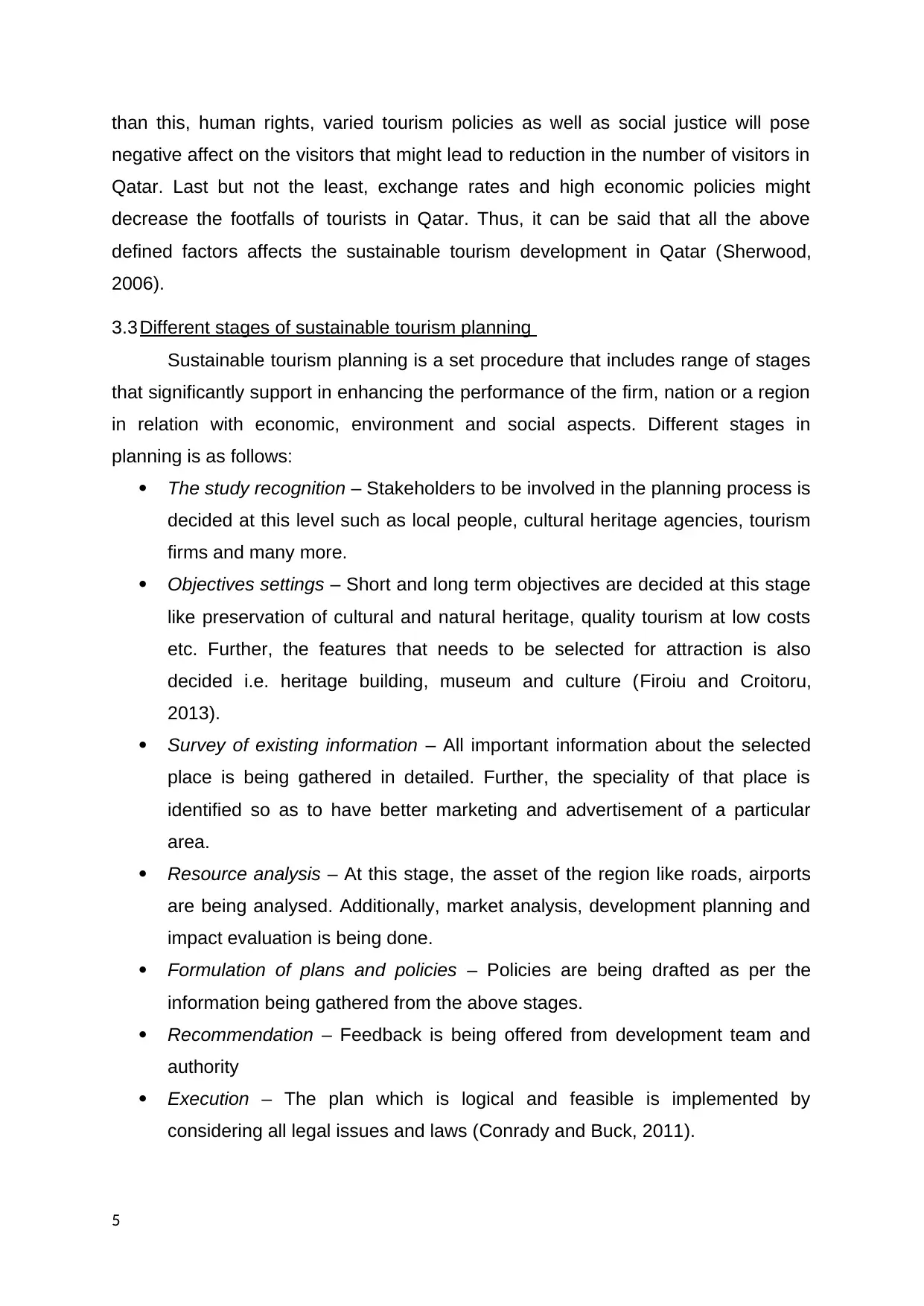
than this, human rights, varied tourism policies as well as social justice will pose
negative affect on the visitors that might lead to reduction in the number of visitors in
Qatar. Last but not the least, exchange rates and high economic policies might
decrease the footfalls of tourists in Qatar. Thus, it can be said that all the above
defined factors affects the sustainable tourism development in Qatar (Sherwood,
2006).
3.3 Different stages of sustainable tourism planning
Sustainable tourism planning is a set procedure that includes range of stages
that significantly support in enhancing the performance of the firm, nation or a region
in relation with economic, environment and social aspects. Different stages in
planning is as follows:
The study recognition – Stakeholders to be involved in the planning process is
decided at this level such as local people, cultural heritage agencies, tourism
firms and many more.
Objectives settings – Short and long term objectives are decided at this stage
like preservation of cultural and natural heritage, quality tourism at low costs
etc. Further, the features that needs to be selected for attraction is also
decided i.e. heritage building, museum and culture (Firoiu and Croitoru,
2013).
Survey of existing information – All important information about the selected
place is being gathered in detailed. Further, the speciality of that place is
identified so as to have better marketing and advertisement of a particular
area.
Resource analysis – At this stage, the asset of the region like roads, airports
are being analysed. Additionally, market analysis, development planning and
impact evaluation is being done.
Formulation of plans and policies – Policies are being drafted as per the
information being gathered from the above stages.
Recommendation – Feedback is being offered from development team and
authority
Execution – The plan which is logical and feasible is implemented by
considering all legal issues and laws (Conrady and Buck, 2011).
5
negative affect on the visitors that might lead to reduction in the number of visitors in
Qatar. Last but not the least, exchange rates and high economic policies might
decrease the footfalls of tourists in Qatar. Thus, it can be said that all the above
defined factors affects the sustainable tourism development in Qatar (Sherwood,
2006).
3.3 Different stages of sustainable tourism planning
Sustainable tourism planning is a set procedure that includes range of stages
that significantly support in enhancing the performance of the firm, nation or a region
in relation with economic, environment and social aspects. Different stages in
planning is as follows:
The study recognition – Stakeholders to be involved in the planning process is
decided at this level such as local people, cultural heritage agencies, tourism
firms and many more.
Objectives settings – Short and long term objectives are decided at this stage
like preservation of cultural and natural heritage, quality tourism at low costs
etc. Further, the features that needs to be selected for attraction is also
decided i.e. heritage building, museum and culture (Firoiu and Croitoru,
2013).
Survey of existing information – All important information about the selected
place is being gathered in detailed. Further, the speciality of that place is
identified so as to have better marketing and advertisement of a particular
area.
Resource analysis – At this stage, the asset of the region like roads, airports
are being analysed. Additionally, market analysis, development planning and
impact evaluation is being done.
Formulation of plans and policies – Policies are being drafted as per the
information being gathered from the above stages.
Recommendation – Feedback is being offered from development team and
authority
Execution – The plan which is logical and feasible is implemented by
considering all legal issues and laws (Conrady and Buck, 2011).
5
Paraphrase This Document
Need a fresh take? Get an instant paraphrase of this document with our AI Paraphraser
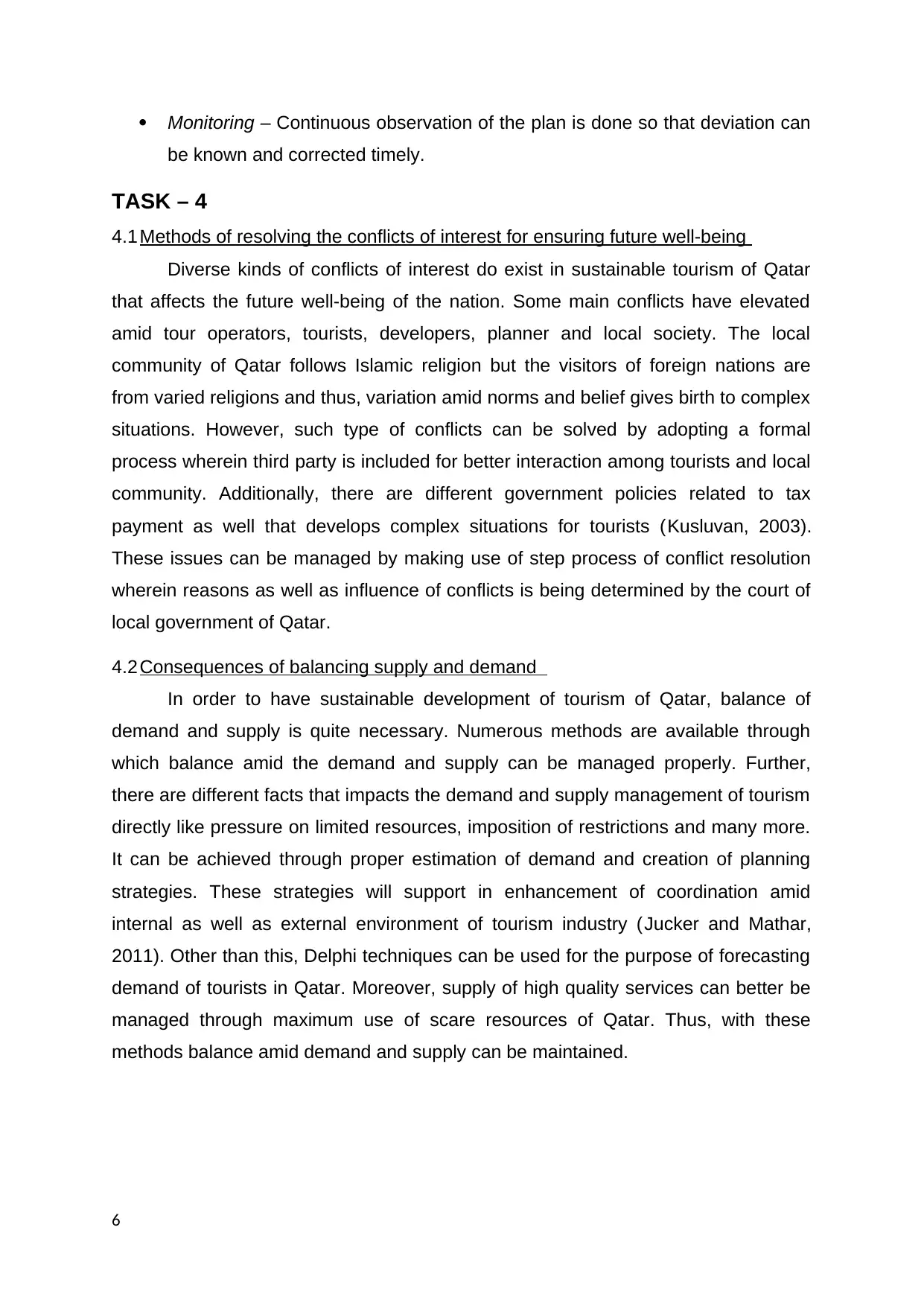
Monitoring – Continuous observation of the plan is done so that deviation can
be known and corrected timely.
TASK – 4
4.1 Methods of resolving the conflicts of interest for ensuring future well-being
Diverse kinds of conflicts of interest do exist in sustainable tourism of Qatar
that affects the future well-being of the nation. Some main conflicts have elevated
amid tour operators, tourists, developers, planner and local society. The local
community of Qatar follows Islamic religion but the visitors of foreign nations are
from varied religions and thus, variation amid norms and belief gives birth to complex
situations. However, such type of conflicts can be solved by adopting a formal
process wherein third party is included for better interaction among tourists and local
community. Additionally, there are different government policies related to tax
payment as well that develops complex situations for tourists (Kusluvan, 2003).
These issues can be managed by making use of step process of conflict resolution
wherein reasons as well as influence of conflicts is being determined by the court of
local government of Qatar.
4.2 Consequences of balancing supply and demand
In order to have sustainable development of tourism of Qatar, balance of
demand and supply is quite necessary. Numerous methods are available through
which balance amid the demand and supply can be managed properly. Further,
there are different facts that impacts the demand and supply management of tourism
directly like pressure on limited resources, imposition of restrictions and many more.
It can be achieved through proper estimation of demand and creation of planning
strategies. These strategies will support in enhancement of coordination amid
internal as well as external environment of tourism industry (Jucker and Mathar,
2011). Other than this, Delphi techniques can be used for the purpose of forecasting
demand of tourists in Qatar. Moreover, supply of high quality services can better be
managed through maximum use of scare resources of Qatar. Thus, with these
methods balance amid demand and supply can be maintained.
6
be known and corrected timely.
TASK – 4
4.1 Methods of resolving the conflicts of interest for ensuring future well-being
Diverse kinds of conflicts of interest do exist in sustainable tourism of Qatar
that affects the future well-being of the nation. Some main conflicts have elevated
amid tour operators, tourists, developers, planner and local society. The local
community of Qatar follows Islamic religion but the visitors of foreign nations are
from varied religions and thus, variation amid norms and belief gives birth to complex
situations. However, such type of conflicts can be solved by adopting a formal
process wherein third party is included for better interaction among tourists and local
community. Additionally, there are different government policies related to tax
payment as well that develops complex situations for tourists (Kusluvan, 2003).
These issues can be managed by making use of step process of conflict resolution
wherein reasons as well as influence of conflicts is being determined by the court of
local government of Qatar.
4.2 Consequences of balancing supply and demand
In order to have sustainable development of tourism of Qatar, balance of
demand and supply is quite necessary. Numerous methods are available through
which balance amid the demand and supply can be managed properly. Further,
there are different facts that impacts the demand and supply management of tourism
directly like pressure on limited resources, imposition of restrictions and many more.
It can be achieved through proper estimation of demand and creation of planning
strategies. These strategies will support in enhancement of coordination amid
internal as well as external environment of tourism industry (Jucker and Mathar,
2011). Other than this, Delphi techniques can be used for the purpose of forecasting
demand of tourists in Qatar. Moreover, supply of high quality services can better be
managed through maximum use of scare resources of Qatar. Thus, with these
methods balance amid demand and supply can be maintained.
6

4.3 Moral as well as ethical issues related to promotion & development of enclave
tourism
Enclave tourism have varied ethical as well as moral issues like lack of
transportation, financial security, emotional issues, physical safety of visitors, stress,
problems related to health and safety etc. Since, Qatar is a developing nation, huge
number of services are not yet developed. Thus, unsuitability of all these services
will develop all the elaborated issues that can influence the sustainable development
of tourism of Qatar negatively (Mbaiwa, 2005). Furthermore, with the passage of
time, competition is rising continuously in the enclave tourism and therefore, for
Qatar is required to pay attention on corporate social responsibilities to key
stakeholders for refining sustainable development of tourism sector. With these
policies in place, issues can be resolved effectively.
TASK – 5
5.1 Comparison of issues related to tourism development in Qatar and South Africa
Issues Qatar New Zealand
Social
Most of the local communities
follows Islamic religion that pays
attention on moral behaviour
and thus, it supports in having
strong relations with tourists
(Firoiu and Croitoru, 2013)
In New Zealand, there are
various social issues such as
crime, gambling, changing
values, social changes and lack
of moral behaviour
Environment
Issues related to inappropriate
utilization of land, scarce and
water resources. Tourism
industry is also not capable of
preserving natural environment
Problem related to optimum
utilization of resources, water
consumption and pollution are
common environment issues in
New Zealand
Economic
Qatar faces problems related to
low generation of employment
and economic leakage
Fluctuation in the economy is
the main problem being faced
by tourism development in New
Zealand (Lepp and Gibson,
2003)
7
tourism
Enclave tourism have varied ethical as well as moral issues like lack of
transportation, financial security, emotional issues, physical safety of visitors, stress,
problems related to health and safety etc. Since, Qatar is a developing nation, huge
number of services are not yet developed. Thus, unsuitability of all these services
will develop all the elaborated issues that can influence the sustainable development
of tourism of Qatar negatively (Mbaiwa, 2005). Furthermore, with the passage of
time, competition is rising continuously in the enclave tourism and therefore, for
Qatar is required to pay attention on corporate social responsibilities to key
stakeholders for refining sustainable development of tourism sector. With these
policies in place, issues can be resolved effectively.
TASK – 5
5.1 Comparison of issues related to tourism development in Qatar and South Africa
Issues Qatar New Zealand
Social
Most of the local communities
follows Islamic religion that pays
attention on moral behaviour
and thus, it supports in having
strong relations with tourists
(Firoiu and Croitoru, 2013)
In New Zealand, there are
various social issues such as
crime, gambling, changing
values, social changes and lack
of moral behaviour
Environment
Issues related to inappropriate
utilization of land, scarce and
water resources. Tourism
industry is also not capable of
preserving natural environment
Problem related to optimum
utilization of resources, water
consumption and pollution are
common environment issues in
New Zealand
Economic
Qatar faces problems related to
low generation of employment
and economic leakage
Fluctuation in the economy is
the main problem being faced
by tourism development in New
Zealand (Lepp and Gibson,
2003)
7
⊘ This is a preview!⊘
Do you want full access?
Subscribe today to unlock all pages.

Trusted by 1+ million students worldwide
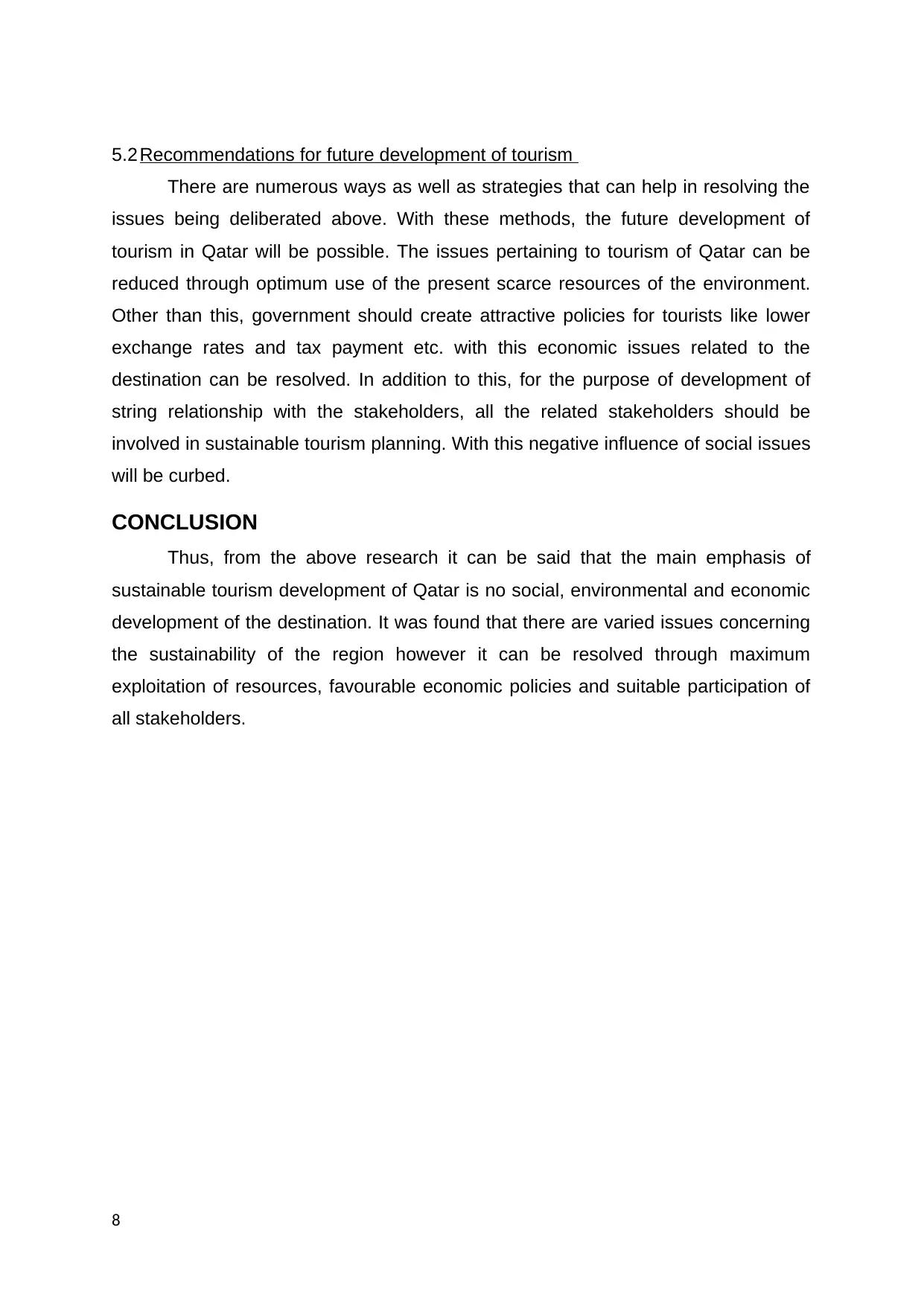
5.2 Recommendations for future development of tourism
There are numerous ways as well as strategies that can help in resolving the
issues being deliberated above. With these methods, the future development of
tourism in Qatar will be possible. The issues pertaining to tourism of Qatar can be
reduced through optimum use of the present scarce resources of the environment.
Other than this, government should create attractive policies for tourists like lower
exchange rates and tax payment etc. with this economic issues related to the
destination can be resolved. In addition to this, for the purpose of development of
string relationship with the stakeholders, all the related stakeholders should be
involved in sustainable tourism planning. With this negative influence of social issues
will be curbed.
CONCLUSION
Thus, from the above research it can be said that the main emphasis of
sustainable tourism development of Qatar is no social, environmental and economic
development of the destination. It was found that there are varied issues concerning
the sustainability of the region however it can be resolved through maximum
exploitation of resources, favourable economic policies and suitable participation of
all stakeholders.
8
There are numerous ways as well as strategies that can help in resolving the
issues being deliberated above. With these methods, the future development of
tourism in Qatar will be possible. The issues pertaining to tourism of Qatar can be
reduced through optimum use of the present scarce resources of the environment.
Other than this, government should create attractive policies for tourists like lower
exchange rates and tax payment etc. with this economic issues related to the
destination can be resolved. In addition to this, for the purpose of development of
string relationship with the stakeholders, all the related stakeholders should be
involved in sustainable tourism planning. With this negative influence of social issues
will be curbed.
CONCLUSION
Thus, from the above research it can be said that the main emphasis of
sustainable tourism development of Qatar is no social, environmental and economic
development of the destination. It was found that there are varied issues concerning
the sustainability of the region however it can be resolved through maximum
exploitation of resources, favourable economic policies and suitable participation of
all stakeholders.
8
Paraphrase This Document
Need a fresh take? Get an instant paraphrase of this document with our AI Paraphraser

REFERENCES
Books and journals
Anderson, W., 2011. Enclave tourism and its socio-economic impact in emerging
destinations. Anatolia, 22(3), pp.361-377.
Bebbington, J., 2007. Accounting for sustainable development performance.
Butterworth-Heinemann.
Bramwell, B., 2011. Governance, the state and sustainable tourism: A political
economy approach. Journal of Sustainable Tourism, 19(4/5), pp.459-477.
Buckley, R., 2012. Sustainable tourism: Research and reality. Annals of Tourism
Research, 39(2), pp.528-546.
Conrady, R, and Buck, M., 2011. Trends and Issues in Global Tourism 2011.
Springer.
Firoiu, D. and Croitoru, A.G., 2013. Tourism and tourism infrastructure from the
perspective of technological changes. Romanian Economic and Business
Review, 8(2), pp.93-103.
Graci, S., 2013. Collaboration and partnership development for sustainable tourism.
Tourism Geographies, 15(1), pp.25-42.
Hazbun, W., 2004. Globalisation, Reterritorialisation and the Political Economy of
Tourism Development in the Middle East. Geopolitics, 9(2), pp.310-341.
Hinch, T. and Higham, J., 2013. Sport tourism development. Channel view
publications.
Jamal, T. and Camargo, B.A., 2014. Sustainable tourism, justice and an ethic of
care: Toward the just destination. Journal of Sustainable Tourism, 22(1)
Jucker, R. and Mathar, R., 2011. Schooling for Sustainable Development in Europe.
Springer.
Kusluvan, S., 2003. Managing employee attitudes and behaviours’ in the tourism
and hospitality industry. Nova Publishers.
Lee, T.H., 2013. Influence analysis of community resident support for sustainable
tourism development. Tourism Management, 34, pp.37-46.
Lepp, A. and Gibson, H., 2003. Tourist roles, perceived risk and international
tourism. Annals of Tourism Research, 30(3), pp.606-624.
Mbaiwa, J.E., 2005. Enclave tourism and its socio-economic impacts in the
Okavango Delta, Botswana. Tourism Management, 26(2), pp.157-172.
9
Books and journals
Anderson, W., 2011. Enclave tourism and its socio-economic impact in emerging
destinations. Anatolia, 22(3), pp.361-377.
Bebbington, J., 2007. Accounting for sustainable development performance.
Butterworth-Heinemann.
Bramwell, B., 2011. Governance, the state and sustainable tourism: A political
economy approach. Journal of Sustainable Tourism, 19(4/5), pp.459-477.
Buckley, R., 2012. Sustainable tourism: Research and reality. Annals of Tourism
Research, 39(2), pp.528-546.
Conrady, R, and Buck, M., 2011. Trends and Issues in Global Tourism 2011.
Springer.
Firoiu, D. and Croitoru, A.G., 2013. Tourism and tourism infrastructure from the
perspective of technological changes. Romanian Economic and Business
Review, 8(2), pp.93-103.
Graci, S., 2013. Collaboration and partnership development for sustainable tourism.
Tourism Geographies, 15(1), pp.25-42.
Hazbun, W., 2004. Globalisation, Reterritorialisation and the Political Economy of
Tourism Development in the Middle East. Geopolitics, 9(2), pp.310-341.
Hinch, T. and Higham, J., 2013. Sport tourism development. Channel view
publications.
Jamal, T. and Camargo, B.A., 2014. Sustainable tourism, justice and an ethic of
care: Toward the just destination. Journal of Sustainable Tourism, 22(1)
Jucker, R. and Mathar, R., 2011. Schooling for Sustainable Development in Europe.
Springer.
Kusluvan, S., 2003. Managing employee attitudes and behaviours’ in the tourism
and hospitality industry. Nova Publishers.
Lee, T.H., 2013. Influence analysis of community resident support for sustainable
tourism development. Tourism Management, 34, pp.37-46.
Lepp, A. and Gibson, H., 2003. Tourist roles, perceived risk and international
tourism. Annals of Tourism Research, 30(3), pp.606-624.
Mbaiwa, J.E., 2005. Enclave tourism and its socio-economic impacts in the
Okavango Delta, Botswana. Tourism Management, 26(2), pp.157-172.
9
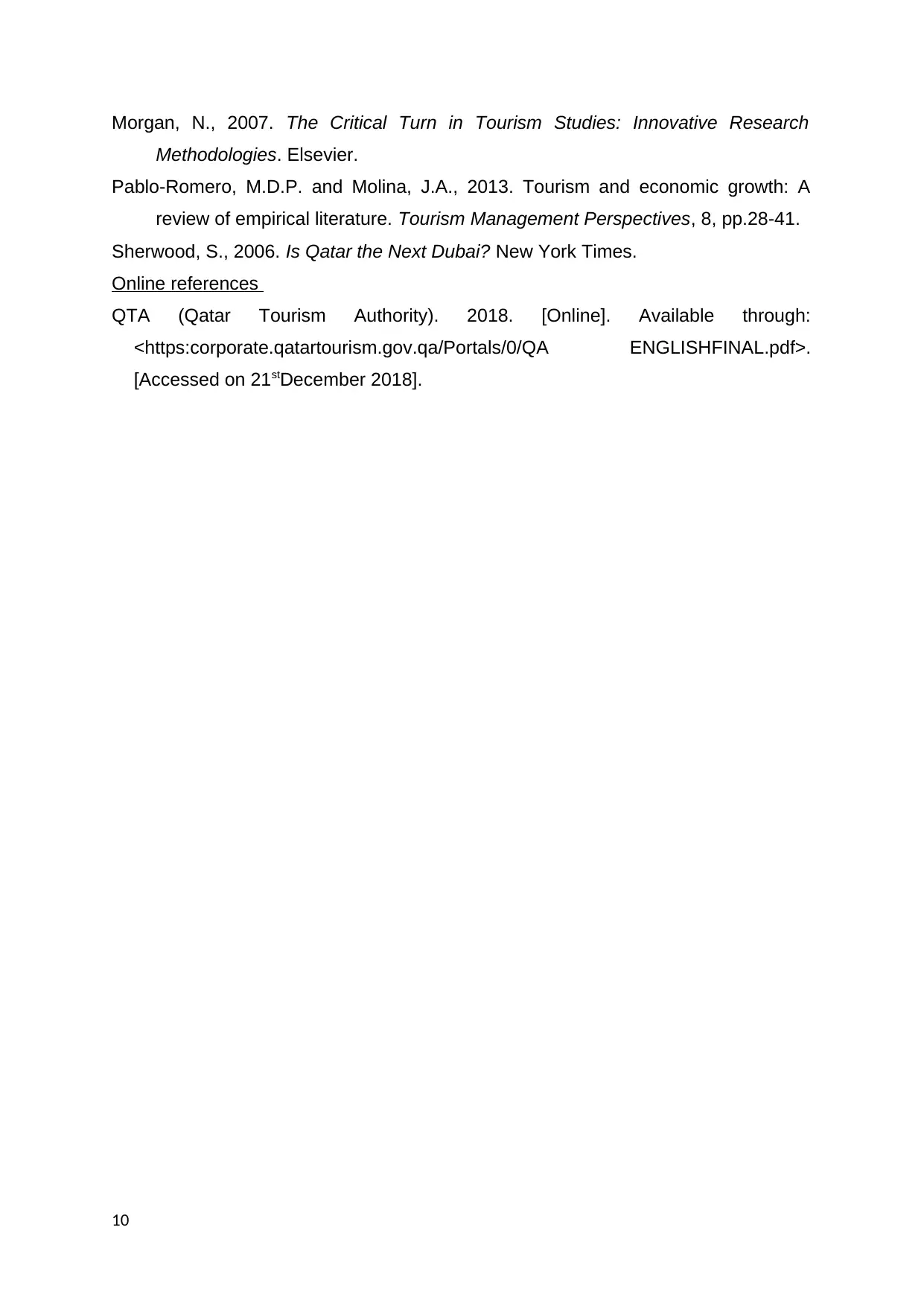
Morgan, N., 2007. The Critical Turn in Tourism Studies: Innovative Research
Methodologies. Elsevier.
Pablo-Romero, M.D.P. and Molina, J.A., 2013. Tourism and economic growth: A
review of empirical literature. Tourism Management Perspectives, 8, pp.28-41.
Sherwood, S., 2006. Is Qatar the Next Dubai? New York Times.
Online references
QTA (Qatar Tourism Authority). 2018. [Online]. Available through:
<https:corporate.qatartourism.gov.qa/Portals/0/QA ENGLISHFINAL.pdf>.
[Accessed on 21stDecember 2018].
10
Methodologies. Elsevier.
Pablo-Romero, M.D.P. and Molina, J.A., 2013. Tourism and economic growth: A
review of empirical literature. Tourism Management Perspectives, 8, pp.28-41.
Sherwood, S., 2006. Is Qatar the Next Dubai? New York Times.
Online references
QTA (Qatar Tourism Authority). 2018. [Online]. Available through:
<https:corporate.qatartourism.gov.qa/Portals/0/QA ENGLISHFINAL.pdf>.
[Accessed on 21stDecember 2018].
10
⊘ This is a preview!⊘
Do you want full access?
Subscribe today to unlock all pages.

Trusted by 1+ million students worldwide
1 out of 12
Related Documents
Your All-in-One AI-Powered Toolkit for Academic Success.
+13062052269
info@desklib.com
Available 24*7 on WhatsApp / Email
![[object Object]](/_next/static/media/star-bottom.7253800d.svg)
Unlock your academic potential
Copyright © 2020–2025 A2Z Services. All Rights Reserved. Developed and managed by ZUCOL.
